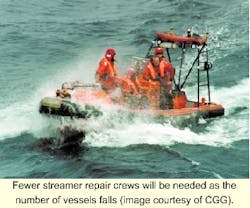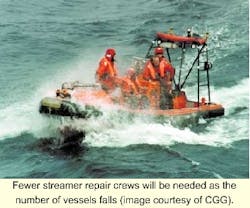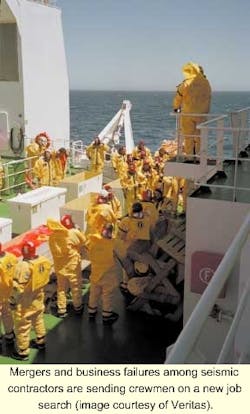SEISMIC EXPLORATION: With weak seismic survey pricing,contractors focus on high-value processing
The world looks like it will be a friendlier place for seismic contractors this year, but it is not yet clear how much more friendly. In 2000, the opening of Brazil created a flurry of big programs to keep vessels busy. The problem was that contractors had to fund a lot of the acquisition themselves, and data sales were thinner than expected for the second year in a row. Acquisition balance sheets had shades of red, and other income sources had to carry the load.
This year, more exploration dollars are available. Increases are placed at about 20% in most financial surveys. So data sales should improve as healthier oil company budgets allow exploration and drilling programs to build momentum. The major problem is that data sales and processing prices have not risen to reflect research advances and the wider array of choices available for oil companies. It is far cheaper to understand the reservoir using seismic technology before major money is spent on drilling.
Acquisition
Will new acquisition programs develop? Will they be regional in nature? There will be a few, especially off West Africa, as more deepwater blocks are made available. Brazil will see new work to in-fill the regional surveys collected last year and as prospects are defined. Little of this will take place without firm participation commitments from oil companies. Contractors' purses are thin.
Watch for more proprietary work over new discoveries, especially the collection of higher resolution 3D surveys as base inputs into 4D earth-models for reservoir modeling and tracking of development drilling. Four-component (4C) seismic is still evolving, but gaining traction. Its effectiveness in the North Sea with gas cloud problems is being applied in other areas.
Fleet technologies
The current fleet is over-built for the level of work presently available. This should change as exploration money begins to flow and as prod-uction departments seek to develop reservoir monitoring and performance tracking models. Fortunately, the seismic contractors have developed a host of new tools to aid field development.
Vessel newbuilds are finished for the foreseeable future. The fleet is entering a consolidation phase. The most spectacular move is the recent WesternGeco joint venture. Both of their predecessors, Schlumberger GecoPrakla and Baker Hughes Western Geophysical, had worldwide fleets. With almost half of the fleet under their joint control, it will be important to watch how they reshape the combined fleet through vessel sales and retirements. It could provide new opportunities for smaller contractors.
The newest vessels carry massive processing capability to service higher streamer counts and many more data channels. Solid streamer technology will begin phasing out older streamers, as inventories are used and replaced. Schlum-berger's Q-technology will begin to find a place as oil companies seek more detailed coverage over large fields.
Bottom surveys
Ocean bottom cable (OBC) technology is improving with some companies claiming to use bottom-laid cables effectively in very deep water. The "Holy Grail" for many production geophysicists is having a repeatable survey tool that will provide 4C data over their deepwater fields. This will allow them to link seismic-extracted rock properties to limited well control data, thus extending reservoir engineering techniques and improving reserve recovery.
There are some problems yet to solve. The advantage of 4C data is that you have another order of magnitude of data to play with. The disadvantage is that 4C interpretation tools are in their infancy.
The interpretation of the data sets will be tedious until automated shear-wave velocity interpretation techniques are developed. Lateral anisotropic relationships affect each reservoir differently. Seismic signals in individual bins will change due to fluid replacement during production.
There is much research and practical work ahead for 4C data and interpretation. OBC contractors who gather data for their own account have an opportunity to develop specialty volumes to help their clients in the future as new tools are developed. In this area, Fairfield has an active program underway.
Processing
Computer processing capacity has jumped substantially over the past five years to accommodate the needs of 3D seismic. With the major acquisition programs diminishing, bulk processing will be reduced, freeing computation power for other work. Even with industry mergers, the computers will be well used.
Pre-stack and post-stack processing has proven its worth in the Gulf of Mexico subsalt play. Expect these techniques to become common tools in other world areas where salt features obscure and distort the reservoir images beneath their overhangs.
Specialty processing will likely provide a stronger profit activity this year than strict data sales. For acquisition companies that own their datasets, new processing can stir life into older data and generate new interest from clients. AVO (amplitude vs. offset) and Kirchoff processes continue to receive plenty of attention and use. Anisotropic processing has much to offer but is not yet widely used.
Reservoir seismic services
An expanding market is developing for reservoir seismic services. This year, more oil companies will be testing the effectiveness of seismic techniques in tracking reservoirs. The goals are to improve decision making, optimize production, and reduce risk, especially dry hole risk as companies seek stranded reserves in older fields.
The primary challenge for contractors in this new market is teasing lithologic information from 3D and 3D-4C data. Depending on bin size, tight volumetric measures are possible. Veritas, with its recent purchase of Reservoir Characterization Research and Consulting (RC2) adds petrophysical expertise to its standard acquisition and processing. The other major seismic contractors are also addressing this new market.
If good rock and fluid properties can be derived from the new seismic data, then tighter control is possible on in-place reserves and on the production of those reserves. Better knowledge of in-place reserves means the oil companies will better know the value of those reserves, which in turn:
- Improves forward revenue modeling
- Tunes a company's cash management
- Improves borrowing capacity
- Guides facilities planning.
Compression/competition
The cost of 3D seismic acquisition and processing is high, but the benefit to the industry is measured in the major new reserves that are discovered in deeper water. It would seem reasonable that the seismic contractors should be getting a return commensurate with that added value. It has not happened.
In part, the fault rests with the contractors. Like drilling rig owners, they tend to overbuild when new technology creates a competitive advantage. Then they settle back and regroup. This is the present stage - consolidation and increased competition for the available work.
In part, it is due to the lag in oil company spending. Variable oil prices squeezed exploration programs in recent years. That is beginning to change. Competition is the key word in the contractor's world. When there are overlapping seismic programs, oil companies have a choice and play one contractor off against another. Merging and consolidation will reduce that overlap and force a change in pricing. Oil companies will groan like any consumer experiencing higher prices (heating oil and natural gas).
People and profits
The current compression in the seismic contractors will likely force many geophysicists into the job market to seek new positions. As demand turns, the contractors will find themselves short-handed again. Their former employees will be on the other side helping the oil companies understand the high-tech data sets the geophysicists helped create. The contractors will be on the front lines again trying to recruit non-existent geophysicists.
Profits are another big question. How will the seismic contractors meet their obligations and generate enough cash to satisfy their stockholders? This year will see the complete restructuring of the contractor market. More mergers and consolidations, even a few failures, will thin the ranks and return price leverage to the contractors.
High-capacity marine acquisition is here to stay, but high-value processing will likely bring the profits. Seismic companies will need to link their client's exploration success to the research, high-tech tools, and superior data that the contractors are delivering.
Prices will rise. The days of commodity pricing for data are quickly dying. Oil companies will likely have to shoot proprietary surveys or buy value-added processing from the service companies to have their data evaluated. Another option is for oil companies to re-establish their processing groups, but that day is likely past.



